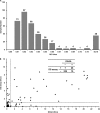Restricted enzooticity of hepatitis E virus genotypes 1 to 4 in the United States
- PMID: 21998412
- PMCID: PMC3232956
- DOI: 10.1128/JCM.05481-11
Restricted enzooticity of hepatitis E virus genotypes 1 to 4 in the United States
Abstract
Hepatitis E is recognized as a zoonosis, and swine are known reservoirs, but how broadly enzootic its causative agent, hepatitis E virus (HEV), is remains controversial. To determine the prevalence of HEV infection in animals, a serological assay with capability to detect anti-HEV-antibody across a wide variety of animal species was devised. Recombinant antigens comprising truncated capsid proteins generated from HEV-subgenomic constructs that represent all four viral genotypes were used to capture anti-HEV in the test sample and as an analyte reporter. To facilitate development and validation of the assay, serum samples were assembled from blood donors (n = 372), acute hepatitis E patients (n = 94), five laboratory animals (rhesus monkey, pig, New Zealand rabbit, Wistar rat, and BALB/c mouse) immunized with HEV antigens, and four pigs experimentally infected with HEV. The assay was then applied to 4,936 sera collected from 35 genera of animals that were wild, feral, domesticated, or otherwise held captive in the United States. Test positivity was determined in 457 samples (9.3%). These originated from: bison (3/65, 4.6%), cattle (174/1,156, 15%), dogs (2/212, 0.9%), Norway rats (2/318, 0.6%), farmed swine (267/648, 41.2%), and feral swine (9/306, 2.9%). Only the porcine samples yielded the highest reactivities. HEV RNA was amplified from one farmed pig and two feral pigs and characterized by nucleotide sequencing to belong to genotype 3. HEV infected farmed swine primarily, and the role of other animals as reservoirs of its zoonotic spread appears to be limited.
Figures




References
-
- Arankalle V. A., et al. 2001. Prevalence of anti-hepatitis E virus antibodies in different Indian animal species. J. Viral Hepat. 8:223–227 - PubMed
-
- Arankalle V. A., Lole K. S., Deshmukh T. M., Chobe L. P., Gandhe S. S. 2007. Evaluation of human (genotype 1) and swine (genotype 4)-ORF2-based ELISAs for anti-HEV IgM and IgG detection in an endemic country and search for type 4 human HEV infections. J. Viral Hepat. 14:435–445 - PubMed
-
- Batts W., Yun S., Hedrick R., Winton J. 2011. A novel member of the family Hepeviridae from cutthroat trout (Oncorhynchus clarkii). Virus Res. 158:116–123 - PubMed
-
- Chang Y., et al. 2009. Zoonotic risk of hepatitis E virus (HEV): a study of HEV infection in animals and humans in suburbs of Beijing. Hepatol. Res. 39:1153–1158 - PubMed
Publication types
MeSH terms
Substances
Associated data
- Actions
- Actions
- Actions
- Actions
- Actions
LinkOut - more resources
Full Text Sources

